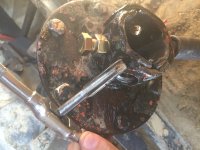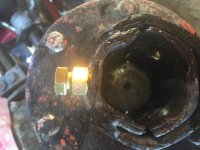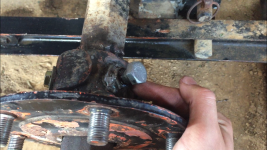Neat 1500
Platinum Member
Those hubs look to have been repaired before. Have they got plates or something welded inside them? It might explain only 1 bolt hole.
you have some wood working skills too I see. Especially the drink holder.! And some good engineering skills and brain to think how to attach all that stuff.
I would say if you have the original rims then the bolt pattern would be the same, if not, who knows.
No, they are 2-piece wheels. The orange color Kubota rims bolted up properly to my black Yanmar centers. Nothing welded. See my sig photo below.... reweld the centers like California had to do to run the Kubota rims on his tractor.
Yes. The problem is that the hub is too loose. There is too much slop between the hub and the axle shaft. I can physically rock the hub back and forth with my hands when the cinch bolt is tightened very tight and the through-bolt is tightened.
Last night I tried to shim the hub with some sheet metal. Did not worked as I had hoped. Later this week I am going to drill and tap a new hole and add a second cinch bolt.
I doubt that shims of any kind will work - the reason being the same reason why there are always a minimum of two hub-fixing bolts on this type of axle hub. It's pretty much a guarantee that no manufacturer is going to use a single bolt in that kind of application. If the manufacturer has design engineers who let that through, their tractors are going to have bigger problems.
I like the drilling and tapping idea. If you are going that way my guess is you have access to a good vise and drill press or maybe a milling machine as well as some metal-working skills. It wouldn't surprise me if you learn more about that hub when you actually get it off and in your hand. Let us know.
Depending on the hole diameter, once you clean things up it might be that you can enlarge and tap the existing pin hole for a second fixing bolt and then drill a dedicated pin hole in the hub somewhere out of plane with the fixing bolts. I wouldn't mind seeing the replacement pin hole slightly closer to the wheel rim if necessary - although I do understand why it is better practice to put it out beyond the fixing bolts. For the hub-fixing bolts I'd either match the metric size or use a similar sized bolt in Imperial (US) thread.
On my YM165D the two hub-fixing bolts are 12mm grade 5 with about 35mm threaded length and a 19mm head. That's a common metric size....and very similar in size & holding capacity to a regular old 1/2" UNC bolt in grade 5 or better with a 3/4" head. Just for S&G, using the metric size gives you about one extra thread over the engaged length in the hub, but the UNC thread form compensates by being a bit stronger in shear.
For holding the bolt torque against backing out, I really like the standard stout spring and washer setup over having the alternative of using a jamb nut against the hub. But those fixing bolts definitely need help to hold against working loose. If it were mine I'd use regular Loktite in the threads plus either the spring or the jam nut. And I'd do that right from the start. Not even give them a chance to work loose. I'll post some info on hub bolt torque in a new thread.
BTW, the stock pin is 10mm diameter....just over a 3/8" US bolt size.
Good Luck,
rScotty
Yep, the sheet metal shims did not work at all.
Funny you say that, I have very rudimentary metal working skills :thumbsup:. I'm typically better when working with wood. But I've pretty much come to the conclusion that I can learn anything if I put my head to it lol. I don't consider myself overly-mechanically inclined, but if I put enough thought into it, I can usually figure it out. I had never owned or operated a tractor before in my life and my first tractor was a non-running Massey Ferguson 35. In my opinion it was a pretty good one to start out with because it was pretty simple to work on. I ended up doing a lot of work to that tractor myself (dialing in the ignition system, installing a new water pump, new thermostat, etc etc).
Anyways, borrowed a tap set last night from my father in law. He only had SAE so I will be tapping it 1/2". Planning to work on it some tonight after work and this weekend. Going to pick up nuts and bolts after work. Have to make time in between there for anniversary dinner with my wife though.
I am considering adding 2 new cinch bolts on each hub, for a total of 3 + through-pin. Once I get the hubs off and look at them I will decide.
I'll try to get some pictures for you guys along the way, but I usually get carried away and forget.



